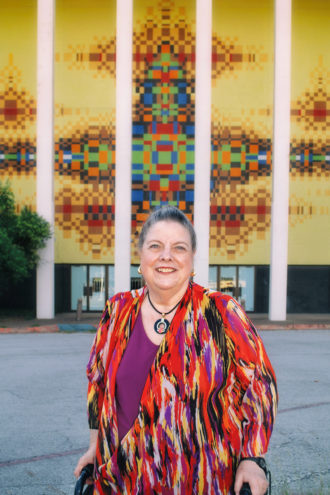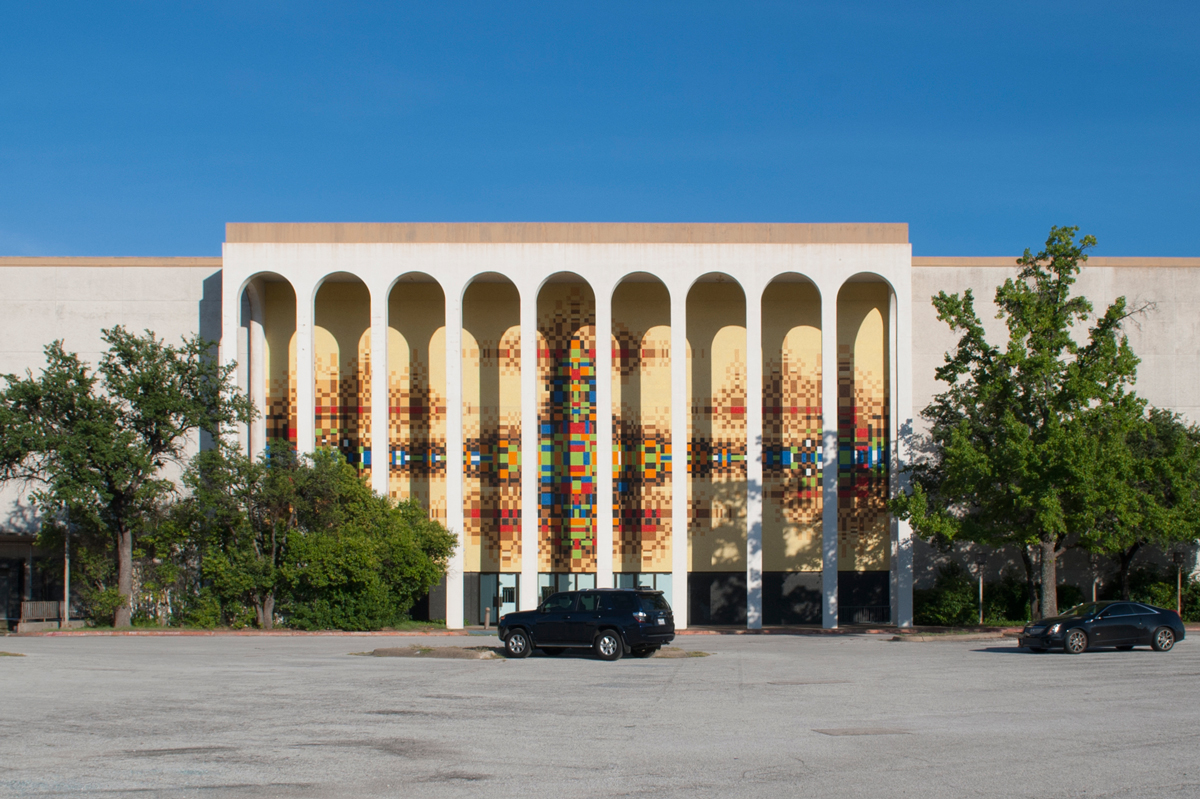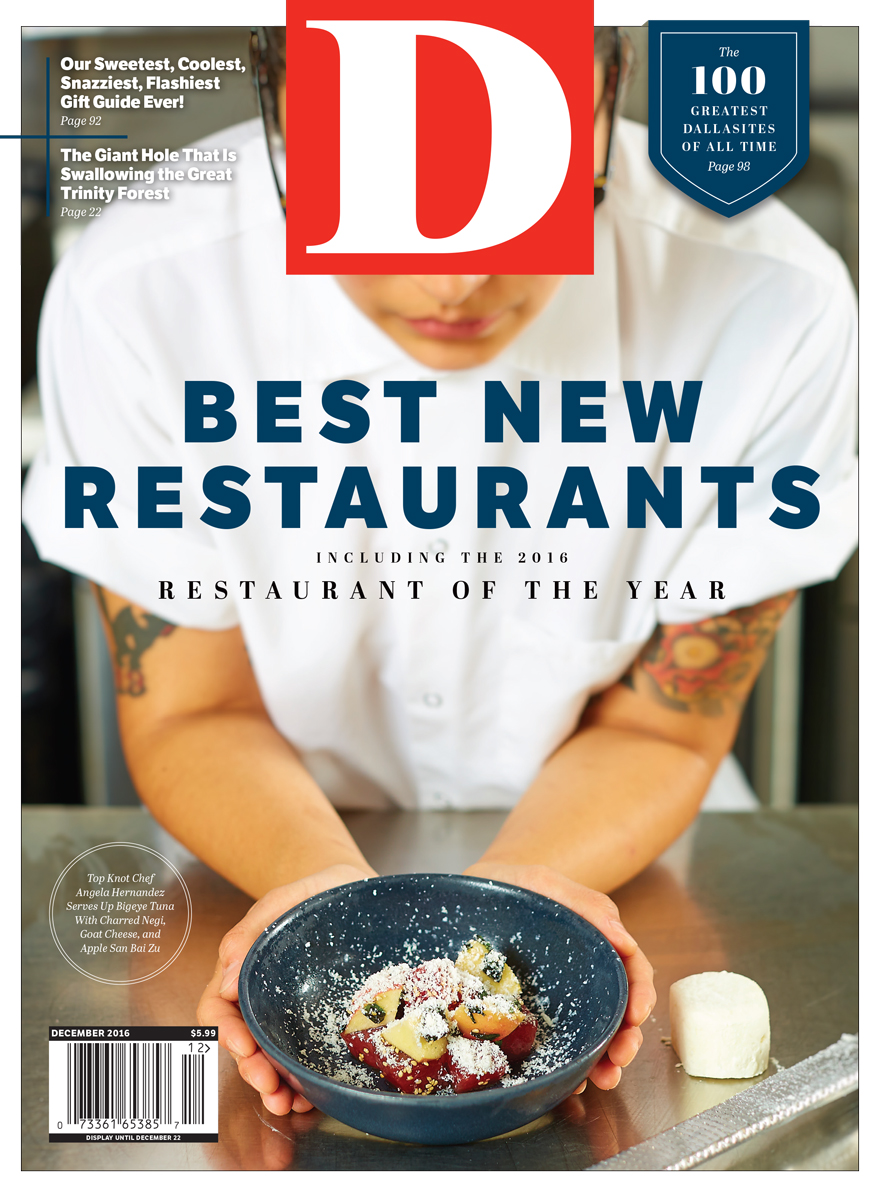Sitting on LBJ at the peak of rush hour, in the summer of 2007, I found myself looking for anything to take my mind off the traffic. The colors and forms of Dallas’ 1980s office boom along the northern stretch of 635 didn’t offer much, with their reflective glass and spectrum of beige, tan, and taupe. Not the type of welcome I expected when I moved here from Kansas. But then Valley View came into focus, and I saw for the first time the mural adorning the Sanger-Harris facade. The captivating pattern of primary colors and bold tones changed my mood and made a lasting impression.
Last summer, my interest in the old mural, created sometime around the 1973 opening of the store, was piqued once again during a panel discussion about the Midtown project hosted by the Dallas chapter of the American Institute of Architects. Throughout the talk flashed images of the mural as the developer and architect of the project walked through details of the impending demolition of Valley View. One image focused squarely on the signature of Brenda J. Stubel, the woman who had created the mural. I would go on to write a short article about this bit of Dallas’ retail history for the September/October issue of Texas Architect.
Throughout my research, though, one thing became clear: there had been no recognition of Brenda Stubel’s contribution other than the signature itself. Old Dallas Morning News stories described the facade as simply “Italian glass tile mural.” I tracked down Robert Young, the longtime architect for the interior of the Sanger-Harris stores. His stories about traveling to hand-pick tile with fellow architect Thomas Stanley and details about the downtown flagship store using an air curtain at its front door all provided a fascinating window into Sanger-Harris’ midcentury evolution—but I still could find no sign of Brenda Stubel. My article had to end with some questions unanswered. But two days after it was published, a reader wrote in: “Brenda is alive and well, living here in Dallas.”

It wasn’t long before I had the opportunity to talk to Stubel. “Ever since I was 8 years old, I wanted to be an architect,” says the Detroit native, who moved to Dallas with her family in 1956. She received her architecture degree from the University of Oklahoma in 1965, one of only four women in her graduating class. From there, she went to Bogota, Colombia, to study housing conditions in a program funded by the United Nations. Back in Dallas, her career took her from the city’s Planning Department, laying out the initial proposal for a regional mass-transit system; to Corgan Associates, working alongside an on-site team that developed the DFW Airport design standards; to OMNIPLAN, the firm behind today’s Midtown project. Throughout it all, she embraced the responsibility that came with being one of the first female architects in Dallas.
“I was always aware of my place in the practice and felt the need to pave the way for a female presence in the profession,” she says. Later, Stubel became a partner with Detroit-based Rossetti Associates, overseeing the development of The Centrum, in Oak Lawn. Her career was cut short, though, after a neurological disorder temporarily paralyzed her, ultimately leaving her with limited mobility.
But long before that turn of events slowed her down, the Sanger-Harris mural project landed on her desk. After Sanger-Harris completed its flagship store in 1965, the chain turned to Harold A. Berry and Associates to express the company’s vision within the rapidly growing suburban mall culture. Stubel worked on the first of three Sanger-Harris rollouts in the region, at Six Flags Mall in Arlington. Designed in partnership with RYA, that store took on the Greek-influenced colonnade characteristic of the flagship location. But the mural presented a problem. Using the same Italian glass tiles and pattern language as the downtown store proved too costly, so the architects cut it from the store’s designs. But Sanger-Harris pushed back. So, to cut costs, they imported mosaic tile from Mexico and asked the youngest kid in the office to design the pattern. That was Stubel.
She took inspiration from the Spanish-influenced design of Six Flags Mall. “The pattern focused on blocks of color in broad strokes,” she says. “We were dealing with freeway recognition, and colors would catch the eye as well as define the entry. Indian and Mexican cultural influences were part of the language. Music would play a role in defining the rhythm of the pattern.”
Using colored pencil on a thick stock of paper, she experimented with patterns and forms. “My musical background came together with architecture in this mural,” she says. Stubel would go on to design two more stores: Town East Mall, whose mural has since been removed, and Valley View, whose three-sided murals were the largest completed outside of the flagship store.
Six Flags Mall was demolished in late October, as D Magazine went to press. With Valley View slated to come down perhaps as early as this month, the murals have once again become a topic in the design community. Suzanne Massey, the director of community relations at SMU, has taken a central role in exploring preservation efforts of the Valley View murals. “I grew up in Dallas. My parents lived 10 minutes from Valley View Mall,” she says. “It is a place of familiarity, and the murals are part of the fabric of North Dallas. When I heard about the Midtown development and the impending demolition of Valley View, no one was saying anything about the mosaics. I think preserving history such as this is important in our cities.”
A group formed by Massey has explored options for saving the murals, but the task is daunting. Given their size, it might take 18 months to remove all three murals. The Dallas Park and Recreation Department has offered to keep the tiles at the Boneyard, its construction storage site near Fair Park. But would the murals even survive the removal and transport? The team has turned its attention toward removing just one, yet the big question remains: where would the mural be reinstalled?
Massey and Stubel agree that the mural should find its new home near the community where it once resided. “I still believe the historical value in the murals lies in or near their respective stores,” Stubel says. “This was the first step in the evolution of Sanger-Harris stores and reflected the larger cultural shift in retail as well as the city’s fabric during the period. The murals should remain in the fabric of the neighborhood.” In Far North Dallas, both women believe, the murals can add a valued piece of artwork to communities seeking a cultural connection.
If Far North Dallas is not a fit, Stubel provided a list of places for the murals to reside. Attached to the list were also a number of action steps, a proposed timeline, and potential donors. Once a project manager, always a project manager. Only this time, she’s working to save a thousand tiny pieces of herself.
Michael Friebele is an associate at CallisonRTKL.






